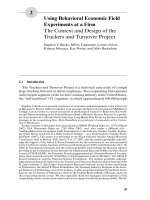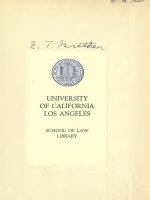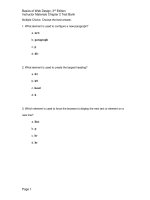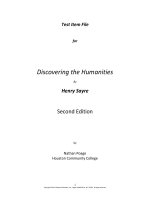The humanities culture continuity and change volume 2 2nd edition henry m sayre test bank
Bạn đang xem bản rút gọn của tài liệu. Xem và tải ngay bản đầy đủ của tài liệu tại đây (177.02 KB, 15 trang )
1
Test Item File
for
Henry Sayre’s
The Humanities
Second Edition
Volume 2
by
Jennifer Rosti
Roanoke College
2
© 2011 by PEARSON EDUCATION, INC.
Upper Saddle River, New Jersey 07458
All rights reserved
10 9 8 7 6 5 4 3 2 1
ISBN 0-20-501261-2
Printed in the United States of America
3
Table of Contents
Chapter 21
4
Chapter 22
10
Chapter 23
16
Chapter 24
21
Chapter 25
27
Chapter 26
33
Chapter 27
39
Chapter 28
45
Chapter 29
50
Chapter 30
56
Chapter 31
62
Chapter 32
67
Chapter 33
73
Chapter 34
79
Chapter 35
85
Chapter 36
91
Chapter 37
97
Chapter 38
103
Chapter 39
109
Chapter 40
115
4
Chapter 21: The Baroque in Italy:
The Church and Its Appeal
Multiple Choice
1. What did Bernini aim to symbolize with his oval colonnade that encloses Vatican Square?
a. The world converging at the church
b. The classical tradition of the church
c. The motherly arms of the church
d. The expansive reach of the church
Answer: c
page 677
2. What is a defining characteristic of Baroque art?
a. Attention to viewers’ emotional experience of a work
b. Return to the forms and proportions of classical art
c. Focus on the symbolic meaning of a work
d. Absence of excessive decoration and sensuousness
Answer: a
page 677
3. What is the meaning of the Portuguese term barroco, from which “Baroque” likely derived?
a. Flamboyant
b. Misshapen pearl
c. Ecstasy
d. Sailor
Answer: b
page 677
4. Why was Baroque originally used in a derogatory way to describe this new style?
a. It was associated with the common people
b. It was very expensive to create
c. It defied the Council of Trent’s directives
d. It was seen as too ornate and strange
Answer: d
page 677
5. Why did the Baroque artists place elements on a diagonal, not the Renaissance frontal and
parallel planes?
a. To evoke a sense of depth
b. To induce more defined shadows
c. To produce a sense of action
d. To provide more balance
Answer: c
page 679
6. Why did Pope Urban VIII commission a baldachino (canopy) for Saint Peter’s interior?
a. To cover Saint Paul’s tomb
b. To define the altar space
c. To crown the papal throne
d. To encircle Michelangelo’s Pietà
Answer: b
page 680
5
7. Why did Bernini decorate the baldachino’s grooved columns with bronze vines?
a. To symbolize the union of the Old and New Testaments
b. To create a sense of naturalism on the columns
c. To emphasize the blending of classical and Italian design
d. To draw the viewers’ eyes upward along the spirals
Answer: a
page 680
8. In his Cornaro Chapel sculptural program, with what did Bernini equate Saint Teresa’s religious
visions?
a. Spiritual rebirth
b. Duality of body
c. Sexual orgasm
d. Ecstatic dancing
Answer: d
page 682
9. Why did Bernini include theater boxes on each side his Cornaro Chapel sculptural program?
a. To allow visitors to have a better view of Saint Teresa
b. To create preferential seating for the Cornaro family
c. To emphasize his design’s high drama
d. To provide extra seating for the churchgoers
Answer: c
page 681
10. What did Bernini intend his Four Rivers Fountain to represent?
a. Triumph of the Roman Catholic Church over the world’s rivers
b. Holy Roman Emperor Ferdinand III’s defeat of Egypt
c. Domination of the Roman Catholic Church over paganism
d. The Roman Catholic Church’s position as the center of the world
Answer: a
page 683
11. While his coworkers constructed his designs, what hobby did Bernini pursue?
a. Flower cultivation at the Villa Borghese
b. Writing plays and designing stage sets
c. Amateur archaeology in Rome’s ruins
d. Composing canzonas for religious services
Answer: b
page 683
12. How did Fra Andrea Pozzo create the highly dramatic space in Triumph of Saint Ignatius of
Loyola?
a. Chiaroscuro
b. Tenebrism
c. Foreshortening
d. Invisible complement
Answer: b
page 686
13. Why did Caravaggio portray his subjects in The Calling of Saint Matthew in attire of his time, not
Jesus’s?
a. To use richer colors and brushstrokes
6
b. To conform to other paintings in the series
c. To enable the audience to identify with them
d. To portray the painting’s patrons realistically
Answer: c
page 690
14. What effect does Caravaggio achieve with light in The Calling of Saint Matthew?
a. Transforms the calling into a miracle
b. Identifies which of the subjects is Matthew
c. Shows Jesus bringing the light to sinners
d. Makes Jesus’s entrance seem threatening
Answer: a
page 689
15. What technique that contrasts large areas of dark with smaller illuminated areas did Caravaggio
master?
a. Chiaroscuro
b. Tenebrism
c. Foreshortening
d. Invisible complement
Answer: b
page 690
16. Why was Artemesia Gentileschi so obsessed with the biblical story of Judith beheading
Holofernes that she painted five versions of it?
a. Gentileschi was of Jewish descent
b. Judith was the female equivalent of David
c. Judith was a female artist
d. Gentileschi had been raped
Answer: d
page 692
17. Why was the division between the Council of Trent-rejected secular music and religious
compositions less pronounced in Venice?
a. It traditionally had ignored papal authority
b. It had a large Protestant population
c. It was too far from Rome for any to notice
d. It was not a part of the Holy Roman Empire
Answer: a
page 694
18. Which of the following is not a way Giovanni Gabrieli aimed to make church music more
emotionally engaging?
a. Playing two organs against each other
b. Placing the four choirs in separate areas
c. Adding the first all-female ensemble to the choir
d. Using brass and wood instruments in the music
Answer: c
page 694
19. What is the canzona’s dominant rhythm?
a. Short-long
b. Long-short-short
c. Long-long
7
d. Short-long-long
Answer: b
page 694
20. Why did Gabrieli organize his compositions around a single note—the tonic note?
a. To heighten the sense of harmonic drama
b. To allow more pitch for the voices
c. To create effects of sonority in a cathedral
d. To enable the words to be heard over the music
Answer: a
page 694
21. What inspired the first operas?
a. Gabrieli’s compositions
b. Bernini’s plays
c. The Venetian street processions
d. Ancient Greek drama
Answer: d
page 695
22. What Greek myth inspired Monteverdi’s first opera?
a. Prometheus and Pandora
b. Orpheus and Eurydice
c. Paris and Helen of Troy
d. Zeus and Leda
Answer: b
page 696
23. Why were only girls in Venice’s orphanages given music instruction?
a. Girls would handle the delicate instruments more gently
b. It was assumed that boys would enter the labor force
c. Girls required musical skill to secure a good marriage
d. Venetian orphanages housed only girls
Answer: c
page 697
24. Why did the orphanage directors hope audiences would be dazzled by the orphans’ musical
performances?
a. They would adopt the talented children
b. They would buy tickets to their performances
c. They would help find jobs for the orphans
d. They would donate money to the orphanages
Answer: d
page 697
25. Why is Vivaldi’s The Four Seasons known as program music?
a. He composed it for one of the orphans’ performances, or programs
b. Its purely instrumental music is connected to a story or idea
c. Its episodes contrast back and forth with the musical score
d. The music follows the program and rhythms of speech
Answer: b
page 696
26. As reported in the chapter’s ”Continuity and Change“ section, why did Louis XIV reject Bernini’s
design for a new façade for the Louvre?
8
a. It looked too similar to the Vatican colonnade
b. It was too simple and classically inspired
c. It would be too expensive to build
d. It was too elaborate and ornate
Answer: d
page 699
27. What did Louis XIV’s rejection of Bernini’s plan mark in European culture?
a. The beginning of the Counter-Reformation
b. The end of Italian art and architecture’s dominance
c. The beginning of the Romantic period
d. The end of classically-inspired designs
Answer: b
page 699
Matching
28. Gian Lorenzo Bernini
a. Canzona Duodecimi Toni
29. Francesco Borromini
b. Conversion of Saint Paul
30. Caravaggio
c. Church of San Carlo alle Quattro Fontane
31. Giovanni Gabrieli
d. Four Rivers Fountain
32. Artemesia Gentileschi
e. The Four Seasons
33. Claudio Monteverdi
f. Judith and Maidservant with Head of Holofernes
34. Andrea Pozzo
g. Orfeo
35. Antonio Vivaldi
h. Triumph of Saint Ignatius of Loyola
Answers: 28-e, 29-c, 30-b, 31-a, 32-f, 33-g, 34-h, 35-e
Essay
36. Describe Bernini’s colonnade enclosure of Vatican Square, and explain how it defines the
Baroque style.
37. Identify and describe three elements of Bernini’s Cornaro Chapel sculptural program that
illustrate the high drama of the Baroque.
38. Compare Bernini’s Baroque David to Michelangelo’s Renaissance David, explaining how each is
representative of its respective period.
39. Compare Andrea Pozzo’s Baroque Triumph of Saint Ignatius of Loyola to Michelangelo’s
Mannerist Last Judgment (Chap. 24), explaining how each is representative of its respective
period.
40. Define tenebrism, and explain Caravaggio’s use of it to provide drama to two of his works.
41. Compare the sensual elements of Bernini’s Ecstasy of Saint Teresa to Caravaggio’s Conversion of
Saint Paul.
42. List and analyze at least two reasons for Artemesia Gentileschi’s use of her self-portrait for
Judith in her five paintings of the Jewish heroine’s story.
43. List and explain two ways Giovanni Gabrieli made church music more emotionally engaging.
9
44. Provide a detailed explanation for the reasons opera developed during the Italian Baroque
period.
45. Using one sculpture, one painting, and one musical composition, explain the artists’
achievement of Baroque drama—the sense of action, excitement, and sensuality.
10
Chapter 22: The Secular Baroque in the North:
The Art of Observation
Multiple Choice
1. What is the meaning of the Dutch word landschap, from which “landscape” derives?
a. Flat
b. Land form
c. Farm
d. Geography
Answer: b
page 704
2. Why was portraiture especially popular with the middle-class seventeenth-century Dutch?
a. Physical connection to their ancestors
b. Only art acceptable to Dutch Reformed Church
c. Affirmation of their financial well-being
d. Expression of their dislike for lavish Baroque art
Answer: c
page 704
3. Which of the following is not a contradiction of seventeenth-century Amsterdam residents?
a. Advocated harmony among others, viciously warred with the Spanish
b. Avidly collected art for homes, banned art in churches
c. Intolerant of religious heresy among Protestants, tolerant of Catholics and Jews
d. Obsessed with acquisition of material goods, rigidly austere in religious life
Answer: a
page 705
4. Why did the Dutch rebel against the Spanish in 1567?
a. The Spanish armada blockaded Amsterdam’s port
b. Philip II transferred the Spanish banking from Amsterdam to Madrid
c. The Spanish opened the dikes, flooding the Dutch farmland
d. Philip II reorganized their churches under Catholic hierarchy
Answer: d
page 705
5. From where did Europe receive the first load of tulip bulbs?
a. China
b. India
c. Turkey
d. The Congo
Answer: c
page 706
6. What creates the “broken” tulip, so highly valued by the seventeenth-century Dutch?
a. A virus
b. Cross-breeding
c. A mutation
d. A fungus
Answer: a
page 706
7. Why in 1637 did the Dutch economy come close to collapse?
a. Widespread flooding of tulip fields
11
b. Frenzied speculation in tulip futures
c. Rampant virus in tulip crop
d. inflation caused by tulip craze
Answer: b
page 706
8. What requirement did the Dutch state place on people in public service?
a. Be a graduate of a Dutch university
b. Not be involved in tulip investing
c. Not be of Spanish descent
d. Be a member of the Dutch Reformed Church
Answer: d
page 707
9. Why in 1618 were some members expelled from the Dutch Reformed Church and even
imprisoned?
a. Belief that good deeds could overcome predestination
b. Refusal to convert from Calvinism to Dutch Reformed
c. Belief that predestination was independent of faith
d. Refusal to remove religious art from their churches
Answer: a
page 707
10. What manner of inquiry did Francis Bacon advocate?
a. Dialectic method
b. Deductive reasoning
c. Cartesian method
d. Empirical method
Answer: d
page 708
11. According to Francis Bacon, what were the greatest obstacles to human understanding?
a. Lack of education and superstition
b. Superstition and religion
c. Religion and prejudice
d. Prejudice and superstition
Answer: b
page 708
12. Which of the following is not one of Bacon’s four major categories of false notion?
a. Idols of the Market Place
b. Idols of the Theater
c. Idols of the Tribe
d. Idols of the King
Answer: d
page 708
13. What manner of inquiry did René Descartes advocate?
a. Dialectic method
b. Deductive reasoning
c. Inductive reasoning
d. Empirical method
Answer: b
page 709
12
14. According to Descartes, what was God?
a. Pure love and total acceptance
b. The mover of the universe
c. The mathematical order of nature
d. The determiner of a person’s destiny
Answer: c
page 709
15. What branch of mathematics did Descartes found?
a. Homological algebra
b. Finite mathematics
c. Calculus
d. Analytic geometry
Answer: d
page 709
16. Why were the Catholic and the Protestant Churches opposed to Kepler’s and Galileo’s
heliocentric theory?
a. For contradicting certain biblical passages
b. For resembling the pagan myths about Apollo
c. For challenging belief in God as creator
d. For implying the existence of other solar systems
Answer: a
page 711
17. Of what does a vanitas painting remind the viewer?
a. To avoid the pleasures of everyday life
b. To appreciate the beauty in nature
c. To focus on the spiritual, not the material
d. To enjoy the pleasures of everyday life
Answer: c
page 712
18. Why did Johannes Goedaert paint a broken and empty nautilus shell beside the vase in his
Flowers in a Wan-li Vase with Blue-Tit?
a. To emphasize the exotic origin of the Ming vase
b. To symbolize worldly wealth, vanity, and mortality
c. To balance the bird on the canvas’s other side
d. To parallel the shape of the tulips’ open blooms
Answer: b
page 712
19. What do most of Jan Vermeer’s 34 painting depict?
a. The symmetry of Dutch domestic architecture
b. A moment in the domestic world of women
c. National pride in Dutch land reclamation
d. A civic institution’s membership at a particular time
Answer: b
page 715
20. What might the pearls In Vermeer’s Woman with a Pearl Necklace represent?
a. Wealth
b. Foreign trade
c. Purity
13
d. Greed
Answer: c
page 715
21. In The Little Street why does Vermeer include a half-whitewashed wall and a mortar-filled
cracked façade?
a. To show the tensions of domestic life
b. To symbolize Protestants and Catholic division
c. To emphasize the differences between two houses
d. To acknowledge the disparity between classes
Answer: a
page 716
22. Why was Rembrandt’s Captain Frans Banning Cocq Mustering His Company once mistitled The
Night Watch?
a. It was covered with grime
b. Captain Cocq was a Spanish spy
c. Rembrandt never titled it
d. The subject’s name was unknown
Answer: a
page 718
23. Why was Rembrandt so interested in self-portraiture?
a. He wished to emulate Albrecht Dürer’s self-portrait
b. He suffered from an excess of vanity
c. He aimed to document the changes age brought
d. His own face provided the ideal practice subject
Answer: d
page 719
24. Why in 1656 was Rembrandt forced to declare bankruptcy?
a. His wife’s poor health created massive debt
b. He had a gambling problem
c. His paintings proved unpopular and did not sell
d. He was notorious for living beyond his means
Answer: d
page 719
25. In The Anatomy Lesson of Dr. Tulp, why does Rembrandt illuminate the cadaver?
a. To evoke the executed man’s similarity to Christ
b. To enable the viewer to see the anatomical detail
c. To highlight the impossibility of resurrection
d. To draw the viewer’s eye to the painting’s center
Answer: c
page 720
26. Why can Rembrandt’s late work Slaughtered Ox be viewed as optimistic?
a. Soft light falls on the animal’s carcass
b. The carcass suggests a feast to come
c. The crucifixion pose implies redemption
d. The maid in the doorway represents the Virgin
Answer: b
page 722
27. What provided one of the main forms of entertainment at Dutch family gatherings?
14
a. The performance of keyboard music
b. Fantasias played on an organ
c. Virtuoso performances on the violin
d. The singing of secular madrigals
Answer: a
page 724
28. What distinguished Bach’s cantatas from the simple melodies of the Lutheran chorales on which
they were based?
a. Lush string accompaniments
b. A double chorus
c. Addition of counterpoint
d. Narration by a tenor evangelist
Answer: c
page 725
29. Why can Bach’s fugues be viewed as sublime examples of Cartesian rationalism?
a. Their multiple instruments
b. Their blending of words and strings
c. Their single thematic idea
d. Their mathematical clarity
Answer: d
page 726
30. In Descent from the Cross, discussed in the chapter’s “Continuity and Change” section, why does
Rembrandt push his scene deeper into the canvas than does Rubens in his earlier painting of the
same title?
a. To make his small painting more intimate
b. To remove the viewers from the action
c. To make the subjects look more helpless
d. To accommodate more subjects around the cross
Answer: b
page 727
Matching
31. Francis Bacon
a. Well-Tempered Clavier
32. Johann Sebastian Bach
b. The Geographer
33. Jacob Cats
c. Novian Organum Scientiarum (The New Method of Science)
34. René Descartes
d. The Dancing Couple
35. Judith Leyster
e. The Anatomy Lesson of Dr. Tulp
36. Rembrandt van Rijn
f. The Proposition
37. Jan Steen
g. Houwelick (Marriage)
38. Jan Vermeer
h. Discourse on Method
Answers: 31-c, 32-a, 33-g, 34-h, 35-f, 36-e, 37-d, 38-b
Essay
39. List and define three ways in which seventeenth-century Amsterdam can be considered a city of
contradictions.
40. Summarize the frenzied speculation in tulip bulbs known as “Tulipomania,” including its effects
on the Dutch economy and the people.
15
41. Describe the development, beliefs, and appearance of the Dutch Reformed Church.
42. List and briefly explain Francis Bacon’s four major categories of false notion.
43. Explain the meaning and significance of René Descartes’ famous expression, “Cogito, ergo sum “
(“I think, therefore I am”).
44. Summarize Descartes’ use of deductive reasoning to prove to his satisfaction the existence of
God.
45. Compare Bacon’s empirical method to Descartes’ s deductive reasoning.
46. Explain the effect of the camera obscura and the microscope on the detail-obsessed Dutch
artists .
47. List and describe three of the most popular subjects of Dutch artists.
48. Describe the position of the seventeenth-century Dutch woman as evidenced by the paintings of
Judith Leyster and Jan Vermeer.
49. Using as examples at least two of his works, describe Rembrandt van Rijn’s use and meaning of
light.
50. Describe the developments in Dutch music during the seventeenth century, highlighting
especially the innovations and contributions of Johann Sebastian Bach.









